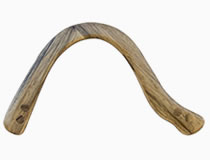LD boomerangs should be thrown and caught at your own risk. These boomerangs are very difficult to control, therefore, they can be dangerous and are not toys. For a successful launch, you need to have good skills in throwing boomerangs. Long-range boomerangs are designed for launches at 70-200 meters or more. To launch, you need a lot of open free space, 150-200 meters or more in all directions. LD boomerangs are heavier than "ordinary" boomerangs, fly farther, faster, have sharp edges and can harm people and other objects.
Conditions for launching
-
Large outdoor area. For example, a football stadium is not suitable because it is very small for this.
-
As a rule, to achieve good results, long-range boomerangs require a uniform wind from 2 to 5 m/s. With the complete absence of wind, it is more difficult to achieve good results, but it is possible.
-
The launch pad should have soft ground so as not to damage the boomerang, and low vegetation in which you can easily lose the boomerang.
Capture
The boomerang may have sharp edges, so it is recommended to use at least one glove. The grip of the boomerang should provide a reliable hold for a strong throw with maximum rotation. Some boomerangs have special notches for fingers on the wings, which help to hold the boomerang more securely when throwing and give more rotation.
The maximum rotation can also be obtained by holding the boomerang between the thumb and index finger. Find a comfortable grip with which you can make a strong and accurate throw.

Throw
Do not make the first throws too strong, see how the boomerang behaves in flight. You should get an elliptical flight path if you did everything right.
As a rule, long-distance boomerangs need to be launched at an angle of 50-80 ° (depending on the setting) to the vertical, and about 30° to the wind (to the right of the wind).
The angle to the horizon should be 5-15 °. If the boomerang immediately starts to rise strongly when throwing, you need to reduce the angle (run closer to the ground).
The throw should be strong, with maximum rotation for stability. For each individual boomerang, there can be its own individual launch parameters. Try throws from different angles. The trajectories can vary greatly even with a slight change in the angles to the horizon and vertical. With the right throw, you should get a smooth elliptical trajectory, with a large rise at the far point.

Boomerang fishing
If you start from tournament rules, then you don't need to catch long-range boomerangs, besides it's not safe. The boomerang can return at high speed, and often it is simply impossible to catch it. However, if the speed is not great and the trajectory and position of the boomerang allow you to catch it, then why not do it.
Launch example
The video shows an example of launching a Naawi boomerang. Depending on the individual characteristics of the boomerang and the launch technique, the trajectory may differ. For example, if the same boomerang is launched with an even greater inclination to 90 degrees, then the trajectory will resemble an S-shaped line.
Solutions to flight problems
The boomerang goes into a large arc or does not return to you - try adding more slope, i.e. closer to the horizontal plane.
Rapid ascent in the first phase of the flight. Try to aim lower to the horizon (lower to the ground).
The boomerang at the far point flies too high and falls to the ground before returning. Reduce the angle of inclination, i.e. hold the boomerang more vertically, and launch a little higher.
The boomerang lands behind you. In this case, running in a more vertical position can also help.



